Where is this monument located? Monument to Marcus Aurelius
An equestrian statue of the Roman emperor Marcus Aurelius has survived only through a mistake. This is the only ancient bronze equestrian monument that has come down to us. There were many such statues in Ancient Rome, but all of them were melted down in the Middle Ages, with the exception of this one, which was considered the image of Emperor Constantine the Great, revered by Christians:

The gilded bronze monument stood for a long time in front of the Pope's residence, the Lateran Palace. In the 16th century, Michelangelo placed it in the center of the Capitoline Square:

In recent years, after restoration, Marcus Aurelius is under the roof of the new hall of the Capitoline Museums. There is now a copy on the square: http://fotki.yandex.ru/users/janet1 981/view/66746/?page=4
It was made using the latest technologies, but, nevertheless, the difference between the original and the copy is colossal. The ancient monument is alive:

The equestrian monument is a monument to the commander. The rider's gesture is addressed to the army. Marcus Aurelius really had to fight a lot in his lifetime with the Parthians, barbarian tribes, but descendants remember him not as a commander, but as a philosopher on the throne. The emperor managed to repel the attacks of enemies and pacify the rebels, but military glory he did not value highly. Marcus Aurelius was one of the most educated people of his time. He devoted all his free time from state concerns to the study of philosophy. We have a book of his thoughts. In it we read: “Look, do not be caesarized, do not be soaked in porphyry - it happens. Keep yourself simple, worthy, uncorrupted, strict, upright, a friend of justice, pious, benevolent, affable, strong for every proper work. Enter the struggle to remain the way the teaching you have accepted wants you to be. Honor the gods, save the people. Life is short; one fruit of earthly existence is a righteous mental warehouse and deeds for the common good.
Marcus Aurelius was born in 121. In 138 he was adopted by Antoninus Pius, from whom he inherited power in 161. The co-ruler of Marcus Aurelius was Lucius Ver, who died in 169. Marcus Aurelius died during a military campaign in 180.


The emperor's horse is magnificent! Winckelmann, the author of the first "History of the Art of Antiquity", believed that "more beautiful and smarter than the head of the horse of Marcus Aurelius cannot be found in nature":

After 13 centuries, this monument served as a model for the sculptors of the Renaissance. When Donatello created an equestrian monument to the condottiere Gattamelata for Padua, he recalled Marcus Aurelius, seen in Rome. And after Donatello, sculptors will turn to this monument for another five centuries.
On the Capitoline Square there is a monument to Marcus Aurelius - the only surviving ancient bronze equestrian statue. The statue survived only because it was considered the image of Emperor Constantine the Great, who patronized Christians and was always deeply revered by them.
Mark Annius Catilius Severus, who went down in history under the name of Marcus Aurelius, was born in Rome on April 26, 121. In 139, he was adopted by Emperor Antoninus Pius, then he became known as Marc Elius Aurelius Ver Caesar. Subsequently, as the emperor wore legal name Caesar Marcus Aurelius Antoninus Augustus (or Marcus Antoninus Augustus).
Aurelius received an excellent education. From the age of twelve he began a serious study of philosophy and was engaged in it all his life. After his death, a philosophical work written by him in Greek "To himself" remained. Thanks to this work, Aurelius went down in history as an emperor-philosopher. From childhood, Mark learned the principles of stoic philosophy and was a model of a stoic: he was a moral, modest person and was distinguished by exceptional stamina in enduring the vicissitudes of life.
“From a very young age, he had such a calm character that neither joy nor grief was reflected in any way on his expression.” In his essay “To Yourself” there are these words: “Always zealously take care that the business in which you this moment busy, to perform as worthy of a Roman and a husband, with full and sincere cordiality, with love for people, with freedom and justice; and also about putting aside all other ideas. You will succeed if you perform every task as if it were the last in your life, free from all recklessness, from disregard for the dictates of reason due to passions, from hypocrisy and dissatisfaction with your fate. You see how few are the requirements by which anyone can live a blissful and divine life. And the gods themselves will not demand anything more from the one who fulfills these requirements.
Time human life- moment; its essence is an eternal flow; sensation is vague; the structure of the whole body is perishable; the soul is unstable; fate is mysterious; fame is unreliable. In a word, everything pertaining to the body is like a stream, pertaining to the soul is like a dream and smoke. Life is a struggle and a journey through a foreign land; posthumous fame- oblivion.
Do not act either against your will, or contrary to the common good, or as a reckless person or succumbing to the influence of some passion, do not clothe your thought in magnificent forms, do not get carried away either by verbosity or busywork ... "
Antoninus Pius introduced Marcus Aurelius to the government in 146, giving him the power of tribune of the people. In addition to Marcus Aurelius, Antoninus Pius also adopted Lucius Verus, so that after his death, power passed immediately to two emperors, whose joint reign continued until the death of Lucius Verus in 169. But during the period of their joint reign, the decisive word always belonged to Marcus Aurelius.
The reign of the Antonine dynasty was perhaps the most prosperous in the history of the Roman Empire, when not only the city of Rome, but also the provinces enjoyed the benefits of peacetime and experienced an economic boom, and the doors of Rome opened wide for the provincials. Aelius Aristides, addressing the Romans, wrote: “Under you, everything is open to everyone. Anyone who is worthy of public office or public trust ceases to be considered a foreigner. The name of a Roman ceased to belong only to the city of Rome, but became the property of all civilized mankind. You have established such a management of the world as if it were a single family.
Nowadays, all cities compete with each other in beauty and attractiveness. Everywhere there are many squares, water pipes, solemn portals, temples, craft workshops and schools. Cities shine with splendor and beauty, and the whole earth blossoms like a garden.”
Ancient historians speak of Marcus Aurelius as follows: “From all other inclinations, Marcus Aurelius was distracted by philosophical studies, which made him serious and concentrated. From this, however, his friendliness did not disappear, which he showed, first of all, in relation to his relatives, then to friends, as well as to less familiar people. He was honest without inflexibility, modest without weakness, serious without sullenness”, “He addressed the people as it was customary in a free state. He showed exceptional tact in all cases when it was necessary either to keep people from evil, or to induce them to do good, richly reward some, justify, showing condescension, others. He made bad people good, and good people excellent, calmly enduring even the ridicule of some. He never showed partiality in favor of the imperial treasury when he acted as a judge in such cases, which could bring benefits to the latter. Distinguished by firmness, he was at the same time conscientious.
However, the lot of the Romans during the reign of Marcus Aurelius fell to many disasters. Life forced the emperor-philosopher to become a brave warrior and prudent ruler.
In 162, the Romans had to launch military operations against the Parthian troops, who invaded Armenia and Syria. In 163, Rome defeated Armenia, and the next year - over Parthia. But neither Armenia nor Parthia were turned into Roman provinces and retained their de facto independence.
The victory of the Romans was largely brought to naught by the fact that in 165 a plague broke out in the Roman troops stationed in the East. The epidemic spread to Asia Minor, to Egypt, and then to Italy and the Rhine. In 167, a plague took over Rome.
In the same year, powerful Germanic tribes of the Marcomanni and Quadi, as well as the Sarmatians, invaded the Roman possessions on the Danube. The war with the Germans and Sarmatians had not yet ended, when unrest began in Northern Egypt.
After the suppression of the uprising in Egypt and after the end of the war with the Germans and Sarmatians in 175, the governor of Syria, Avid Cassius, an outstanding commander, proclaimed himself emperor, and Marcus Aurelius was in danger of losing power. Ancient historians write about this event as follows: “Avidius Cassius, who in the East proclaimed himself emperor, was killed by soldiers against the will of Marcus Aurelius and without his knowledge. Upon learning of the uprising, Marcus Aurelius was not very angry and did not apply any harsh measures to the children and relatives of Avidius Cassius. The Senate declared him an enemy and confiscated his property. Marcus Aurelius did not want it to enter the imperial treasury, and therefore, at the direction of the senate, it passed into the state treasury. Marcus Aurelius did not order, but only allowed Avidius Cassius to be killed, so that it was clear to everyone that he would have spared him if it depended on him.
In 177, Rome fought the Mauritanians and won. In 178, the Marcomanni and other tribes again moved into the Roman possessions. Marcus Aurelius, together with his son Commodus, led the campaign against the Germans, and he managed to achieve great success, but the plague began again in the Roman troops.
From the plague on March 17, 180, Marcus Aurelius died on the Danube in Vindobona (modern Vienna).
In the portraits, Marcus Aurelius appears as a man living an inner life. Everything that arose already under Hadrian is brought to the last line in him. Even those sleekness and external gloss that connected Adrian with the external environment are disappearing. The hair is even thicker and fluffier, the beard is even longer, the chiaroscuro in strands and curls is crushed even brighter. The relief of the face is even more developed, with deep wrinkles and folds. And even more expressive look, conveyed by a very special technique: the pupils are drilled and raised to heavy, half-closed eyelids. The look is the most important thing in a portrait. This is a new look - quiet, withdrawn into itself, detached from earthly fuss.
From the honorary monuments of Marcus Aurelius, a triumphal column in honor of the German and Sarmatian campaigns and an equestrian statue have been preserved. The triumphal column was built in 176-193 on the model of Trajan's column. The column of Marcus Aurelius is made up of thirty marble blocks with a sculptural relief that rises in a spiral and unfolds before the viewer pictures of battles with the Sarmatians and Marcomanni. At the top stood a bronze statue of Marcus Aurelius, which was later replaced by a statue of St. Paul. Inside the column, a staircase of 203 steps is illuminated by 56 light holes. The square, in the center of which stands the column of Marcus Aurelius, is succinctly called Piazza Colonna.
The monumental bronze equestrian statue of Marcus Aurelius was created around 170. In the 16th century, after a long break, the statue was again installed according to the design of Michelangelo in Capitoline Square in Rome on a pedestal of strict form. It is designed to be considered different points vision, impressing with the splendor of plastic forms. Having lived his life on campaigns, Marcus Aurelius is depicted in a toga - the clothes of a Roman, without imperial distinctions. The image of the emperor is the embodiment of the civic ideal and humanity. The concentrated face of the Stoic is full of consciousness of moral duty, peace of mind. With a wide pacifying gesture, he addresses the people. This is the image of a philosopher, the author of "Reflections in private", indifferent to fame and fortune. The folds of his clothes merge him with the mighty body of a magnificently molded slow-moving horse. The movement of the horse, as it were, echoes the movement of the rider, complementing his image. “More beautiful and smarter than the head of the horse of Marcus Aurelius,” wrote the German historian Winckelmann, “cannot be found in nature.”
| |
The Capitol is perhaps the most famous of the hills of Rome. Everyone heard this name at school and most quickly everyone heard the legend of the Capitoline she-wolf who nursed Romulus and Remus, and saw her image in a photograph in a history textbook. The most diligent students probably remember the temple of Capitoline Jupiter and his wife Juno. In antiquity, these were the most beautiful and richest temples in the world. When a general celebrated a victory, he rode down the Via Sacra to the Capitol, dressed as Jupiter, in a chariot drawn by white horses.
But I will disappoint you, no ancient buildings on the Capitol have been preserved to this day. All former splendor has sunk into oblivion. The great temple of Jupiter collapsed and spilled over the hillside. Life returned here again only a few centuries later, when a church dedicated to the Holy Virgin Mary was built on the site of the former temple of Juno, and a fortified palace of the magistrate was erected not far from the former temple of Jupiter.
And yet the Capitoline Hill is no less beautiful today than it was in antiquity. The Capitoline Square was built up in the 15th century according to the design of Michelangelo Buonarroti with three most beautiful palaces and decorated with "antique" statues.
The most convenient way to get to the Colosseo metro station is on the blue line and walk along Via Imperiale for about 1 km past the Colosseum, the Roman Forum and the Forum of Trajan. Capitol Hill will be hidden from you by a massive monument to Victor Emmanuel II. As soon as you go around it, you will immediately see two stairs leading to the Capitol.
Buses No. 40, 170, 492 run from Termini Station. You need to get off at Piazza Venezia, as soon as you see the monument to Victor Emmanuel II, it is so huge that you cannot confuse it with anything.
If you stand facing the monument, then the Capitol will be on the right.
Now there is a busy street in front of the legendary hill, along which buses, cars, motorcyclists scurry back and forth, and probably the inhabitants of Rome are so used to the landscape around them that they stopped paying attention to it. Just like me, driving along the Palace Bridge in St. Petersburg I am more concerned about the presence or absence of traffic jams than the architectural ensemble surrounding me. That's why we travel, to go beyond the usual and throw a new look at the world.
I guarantee you a new look, I will not rewrite the platitudes that the symbols of Rome are 2000 years old, because the Eternal City, how could it be otherwise. I will tell you about new historical data, not yet very popular, but still taking place. The solid age of historical relics is in question. What is written in a school history textbook is not the ultimate truth, it is just one of the versions.

Capitol Hill, stairs to the church of Santa Maria in Araceli on the left
There are two staircases leading up to Capitol Hill. One of them will take you to the square, it is called Cordonata, and the second to the church of Santa Maria in Araceli. My greatest surprise was the fact that it is impossible to go from the church to the square, you have to go down the hill again and climb another staircase. From the Forum side, you can also climb the hill along a quiet highway intended for magistrate employees, but this will be more a back door than a front door.
Statues of the Dioscuri
The entire ensemble of the Capitoline Square was created in 1536-1546 according to sketches by Michelangelo. Those ascending the hill are met by sculptures of the Dioscuri - Castor and Pollux (otherwise it is called Polydeuces). These statues, like many others, were found during excavations in the 16th century and are considered antique.

Dioscuri - Castor and Polydeuces, in the background the Palazzo Senators
Dioscuri - strange twin brothers gave their name to the constellation Gemini. They were born as twins, but they had different fathers, one of them was immortal, the other mortal. modern science such facts about twins with different fathers are not known, but this is a myth. According to myths and legends, the brothers took part in the campaigns of the Argonauts and Trojan War. And on their heads they wore hats-caps in the “shape of a cone from an egg” (quote from Wikipedia), new chronologists would definitely see in these hats a Scythian, and in their opinion, a Russian trace.
Huge statues of the Dioscuri are also installed on the Quirinal Hill, and the ruins of a temple dedicated to the brothers Castor and Pollux have been preserved in the Forum. Obviously, they were very revered in Rome.
Equestrian statue of Marcus Aurelius
In the center of the square stands one of the symbols of Rome, a copy of the antique bronze statue of Marcus Aurelius. The original is now in the Capitol Museum. The fact that the statue belongs to Marcus Aurelius is quite controversial, it’s just that everyone is used to calling it by that name.

Copy of the statue of Marcus Aurelius in the square
The statue is unsigned and has never been signed, it was previously believed that it was Emperor Constantine, and it was attributed to Marcus Aurelius based on a comparison with a portrait on a signed coin in the 12th century. The similarity is quite controversial and approximate in view of the rather rough execution of the imprint on the coin.
The website of the Capitol Museums states that ancient authors do not mention this particular statue, but there are mentions of other 22 equestrian statues much larger than this one, which have not survived to this day. There is also a mention of this statue by the medieval scholar Ricobald from Ferrara. He claims that the statue was cast by order of Pope Clement III (pontificate years 1187-1191). In general, the inconsistencies with determining the age of this statue on the face, the XII century does not pull on antiquity in any way.

Bronze gilded original statue of Marcus Aurelius and a coin (photo from Vicki)
A marble bust and a pair of bas-reliefs depicting the same man are kept in the Capitol Museums. Not far from the Capitoline Hill on the Column Square stands the Antoninus (Marcus Aurelius) column, made in the spirit of Trajan's column, i.e. all covered with bas-reliefs, but without a single signature. He was definitely famous ancient world. Peru Marcus Aurelius also owns philosophical treatises written in Greek and in some ways repeating the principles of Christian morality.
Perhaps Ricobald of Ferrara was right and Marcus Aurelius lived already in the 11th-12th centuries, and only a little later than the death of the emperor, Pope Clement III decided to perpetuate his ebb of this beautiful sculpture? Then the writings of Marcus Aurelius in the spirit of Christian values look quite natural. Or right modern historians who believe that Ricobald did not understand anything about the events surrounding him? But the ancient chronicler was closer to them by 5-6 centuries.
The equestrian statue of Marcus Aurelius was replicated with different riders around the world, we can say this image of a horse and a rider is a classic of sculpture. In St. Petersburg there is a monument to Peter I in a similar pose, Jozef Poniatowski froze in the pose of Marcus Aurelius in front of the presidential palace, there are analogues in the USA and Great Britain.
Capitoline she-wolf
To the left of the Palace of the Senators is a copy of the sculpture of the Capitoline she-wolf. The original, after a recent scandalous restoration, is kept in the Capitol Museums. During the restoration, metallurgy specialist Anna Maria Carruba found that the she-wolf statue was cast in its entirety. Antique bronze sculptures were usually cast in parts, and then soldered, the ancients were not able to work with large volumes of molten metal. This fact shifts the date of manufacture of the sculpture from antiquity to the Middle Ages. The traditional date is 500 BC. supported by ancient authors, but they described a completely different sculpture - a she-wolf licking babies.
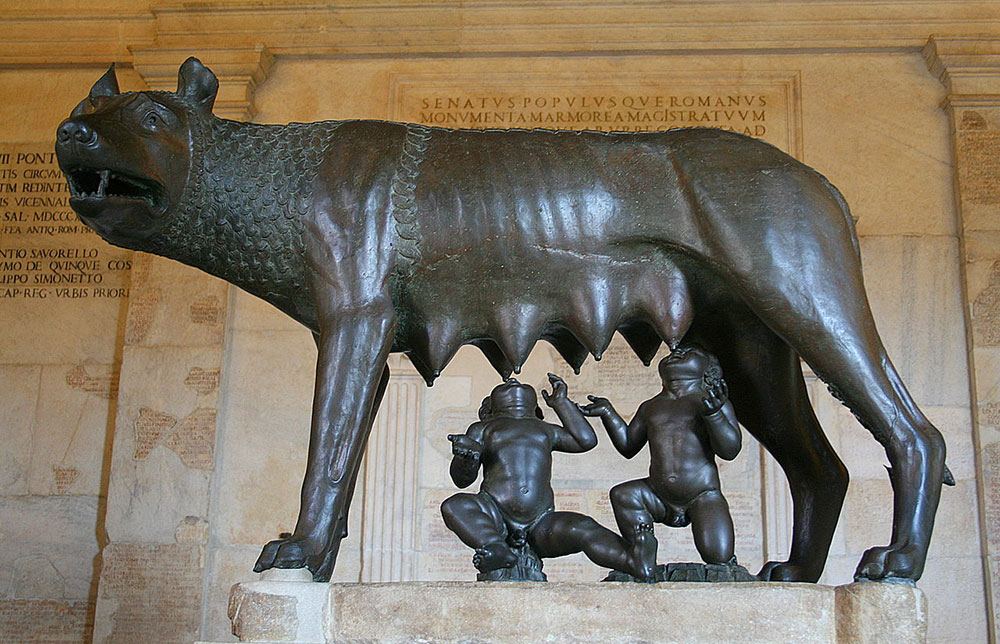
The original sculpture of the Capitoline Wolf in the Capitol Museums (photo from Wikipedia)
Babies were made quite officially in the 15th century, this fact is documented and the name of the sculptor is known. However, despite all the statements of Anna Maria Carruba, the plate with the date of manufacture of the she-wolf figure in the Capitol Museum was not changed.
It is curious that this was the first and only restoration of the sculpture, and it was assumed that it was 2500 years old. I live in St. Petersburg. In my city, too, there are quite a few bronze sculptures, and the city is only 300 years old, but the sculptures are regularly repaired, we are shown this on local television. Even the angel, installed on the Alexandrian Column for less than 200 years, was repaired. Are the sculptures in Rome so durable that they don't need to be repaired?
It would be interesting to know about the results of the restoration of the sculpture of Marcus Aurelius, it was carried out, but the only thing I could find about this was statements that the restoration was equated with a secret operation, a limited number of people were allowed in and they did not give any comments.
The statue of the Capitoline she-wolf is replicated even more than the statue of Marcus Aurelius. We personally saw her also in. All its copies installed around the world are even difficult to count.

Capitoline she-wolf
On the wall next to the she-wolf are numerous memorial plaques praising the work of the Popes in the restoration and repair of buildings on capitol hill, the holy fathers did not forget to perpetuate, first of all, their loved ones. Many plates contain the abbreviation S.P.Q.R. - "Senatus Populus que Romanus" ("The Senate and Citizens of Rome"), although they no longer refer to the times of ancient Rome. The ancient abbreviation S.P.Q.R. with success began to be used in united Italy and I still use it right up to decorating Roman hatches with it.
Mussolini really liked the idea of restoring the empire, so the symbols of ancient Rome, such as the Capitoline she-wolf or the abbreviation S.P.Q.R. widely used by his propaganda.

Capitoline she-wolf
Very close to the Wolf is an absolutely wonderful viewpoint. It offers a breathtaking view of the Forum, Palatine Hill and even the Colosseum. Three columns on the right are just the remains of the temple of the Dioscuri, especially revered in Rome.
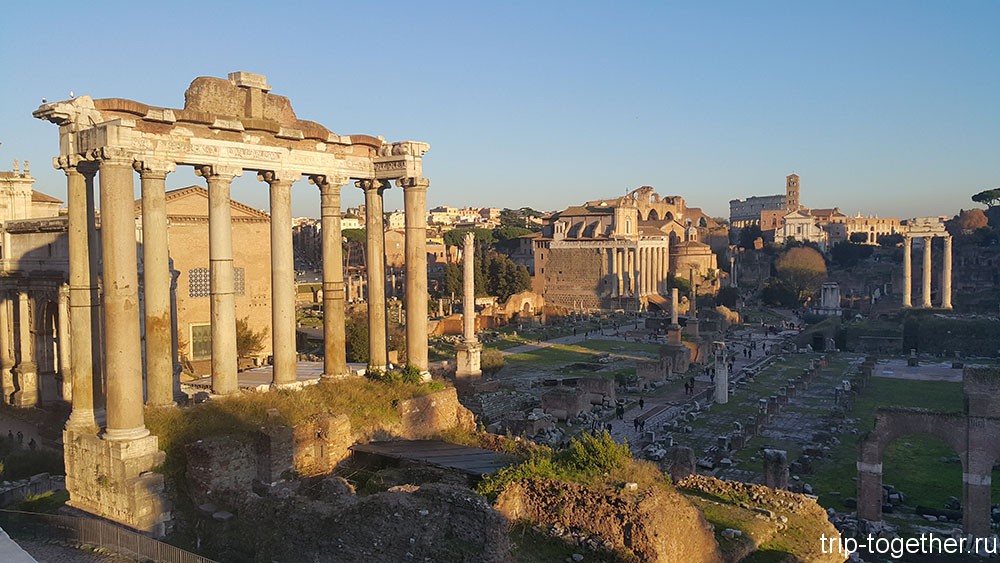
Roman Forum, view from the Capitoline Hill, at the very end of the Colosseum
Museums of the Capitol
The Capitol Museums have a very decent website, all the exhibits are carefully photographed, you can visit the museum virtually and get an idea of \u200b\u200bwould you like to pay 15 euros for a ticket and see the exhibits in full size. There were no queues to these museums in December. We didn't go there.
Museums are located in three palaces - the Palazzo Conservatori, the Palazzo Senators and the Palazzo Nouveau, located around the square.
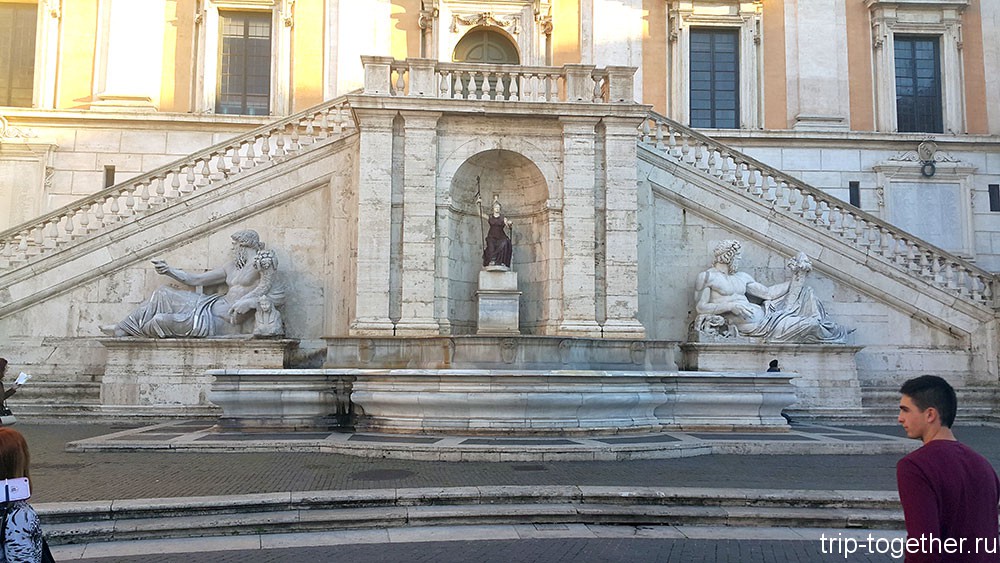
Staircase of the Palazzo Senators
That's actually all about the front part of Capitol Hill. There are still administrative buildings in the entrance hall, and there is a completely different, non-tourist life going on there. Therefore, now we will go down to climb another staircase leading to the church of Santa Maria in Araceli.

Red brick building - Santa Maria in Araceli
On the descent, we noticed a statue at first glance, some kind of monk, but it turned out not to be so. The sculpture is intended to recall the political figure of the Middle Ages Cola di Rienzo (1313-1354, years of life). He was of low birth, but had the gift of an actor and leader of the nation.
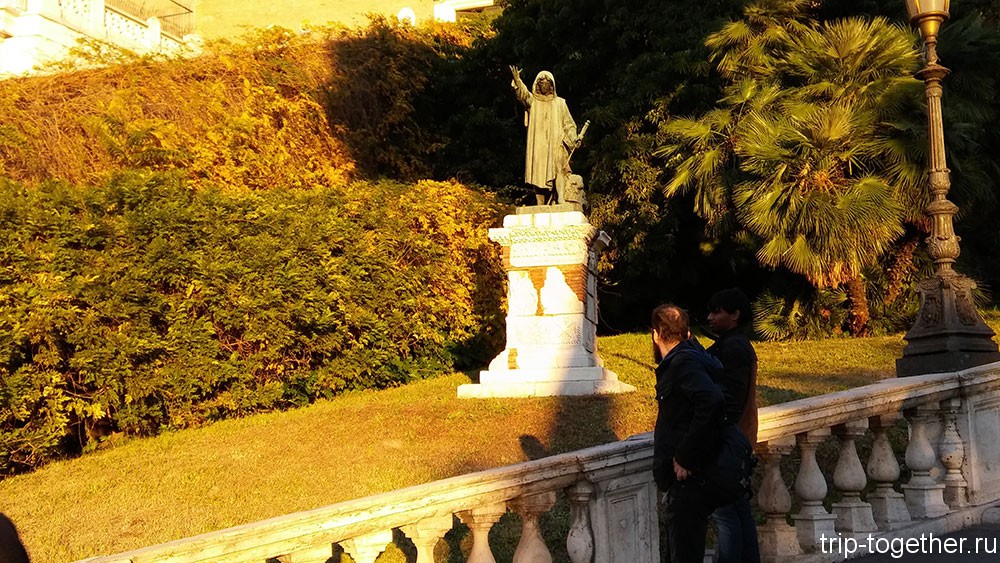
Monument to Cola di Rienzo in Rome
His fiery speeches were a success with the townspeople and at one fine moment Rienzo managed to lead the uprising and become essentially the dictator of Rome, he himself, of course, called himself a people's tribune. His transformations were very useful, the arbitrariness of the barons and robbers began to decline, but nothing lasts forever. The moment came when the offended barons unleashed their wrath on him. It is believed that Rienzo was killed on the very spot where the monument now stands.
And finally, amazing - blooming cyclomenes at the foot of Capitol Hill in December.

cyclomenes
And a cross between a car and a scooter, the Renault Twizy electric car. They say that it is a double seat, but I still don’t understand where the second person is invited to sit, there is only one seat, and there’s nowhere to put the bags from the supermarket.
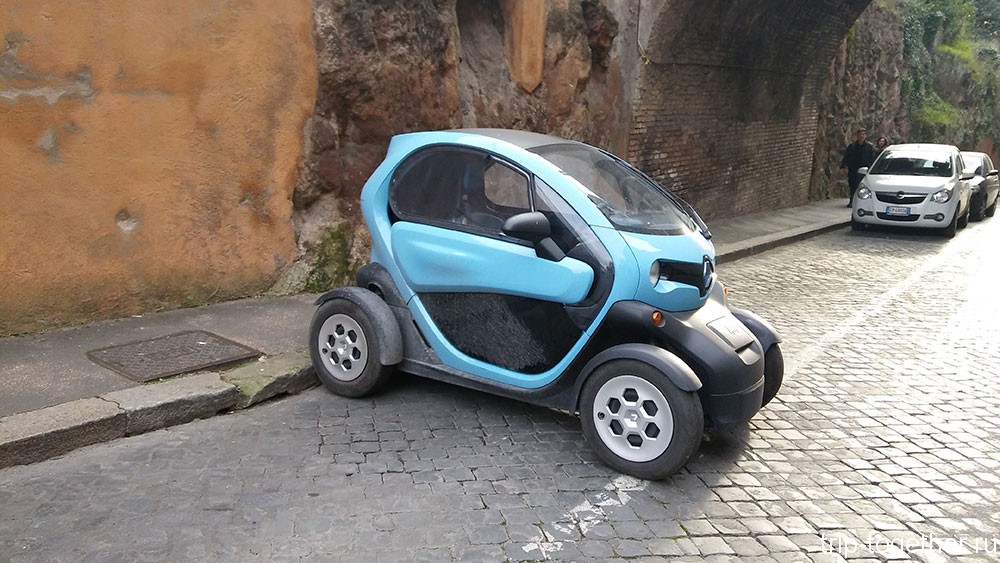
Little Renault on Capitol Hill
In the next article I will tell you, she also stands on Capitol Hill. I thought to fit it into this article, but it turned out to be very long. The church is worthy of overcoming 124 steps made and stones mined in the Colosseum and the Circus Maximus for its sake. A splendid interior awaits you interesting story about the figurine of the baby Christ, nicknamed "Bambino", all studded with diamonds.
Statue of Marcus Aurelius - Roman emperor and philosopher - an ancient Roman bronze statue, which today is located in the Capitoline Square in Rome. It was created in the years 160-180 and today is one of the most frequently visited attractions.
Story

In the twelfth century, a statue of Marcus Aurelius was placed in front of the main residence of the popes - the Laretan Palace. In 1538 it was installed on the Capitoline Square. Almost immediately, Michelangelo Buonarroti began its reconstruction. The work lasted more than one hundred and twenty years, and as a result, the square with three palaces became a magnificent architectural ensemble - one of the brightest sights of Rome.
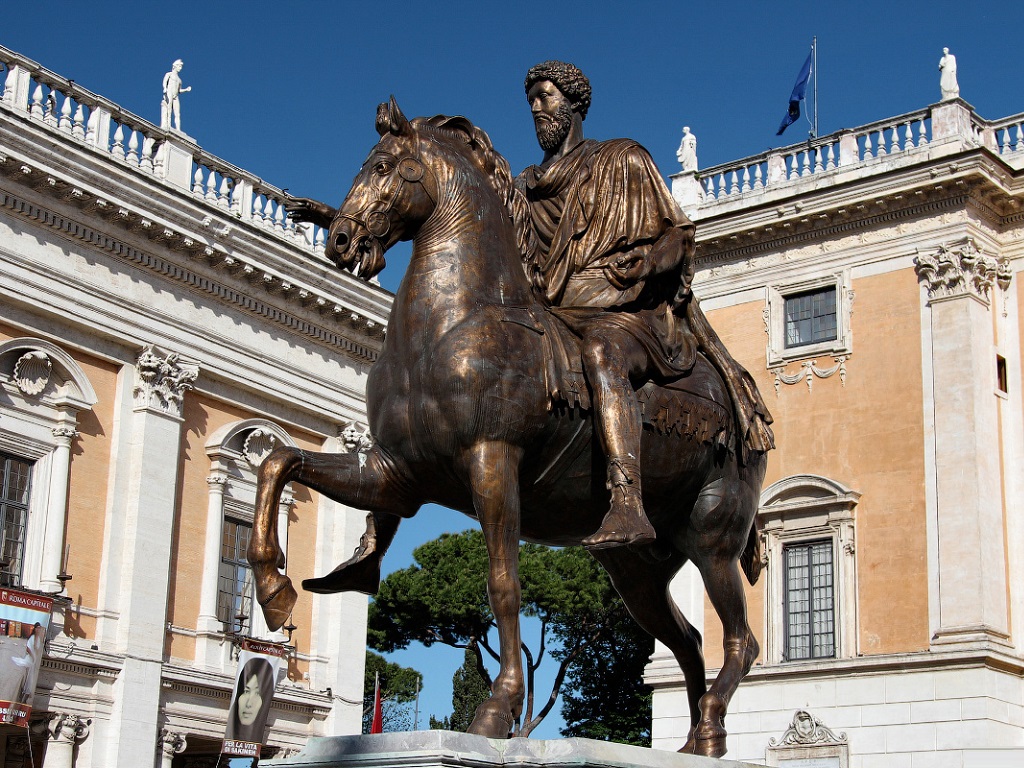
In the Middle Ages, the equestrian statue of Marcus Aurelius was mistaken for the statue of Constantine the Great. The church canonized this emperor as a saint, which saved the monument from destruction, when God's servants called the sculptures created during the time of pre-Christian rulers pagan idols and ordered them to be destroyed.
Copy

At the end of the nineteenth century, an exhibition hall was built for the statue in the Palace of the Conservatives, which is located on Capitoline Square, and a copy was placed on the square itself. Today, the equestrian statue of Marcus Aurelius in Rome attracts the attention of tourists from all over the world.
Description

The statue of Marcus Aurelius in Rome is made of gilded bronze and is the only sculpture of this type that has survived from ancient times. The emperor is depicted wearing a tunic and a soldier's cloak. The composition of the statue is very simple and concise. Marcus Aurelius is depicted not only as a great victorious emperor, but also as a philosopher-thinker. Mark's face is realistic with bulging eyes and protruding cheekbones. The head is tilted forward, the lips are tightly compressed. The emperor's eyes are half covered with upper eyelids. The hairstyle shows a spectacular play of light and shadow, which sets off the outward calmness and concentration of Marcus Aurelius.

Under the raised hoof of the horse, there used to be a figure of a bound barbarian. She was considered a symbol of a defeated enemy, and the gesture of Aurelius meant generosity to the vanquished.
The statue of Aurelius does not have that pretentious solemnity and grandeur that are inherent in the images of other rulers of Rome. In the portrait of the emperor, the master accurately revealed the mood of a person who feels the contradictions of the reality around him and seeks to escape from them into the world of his own experiences.
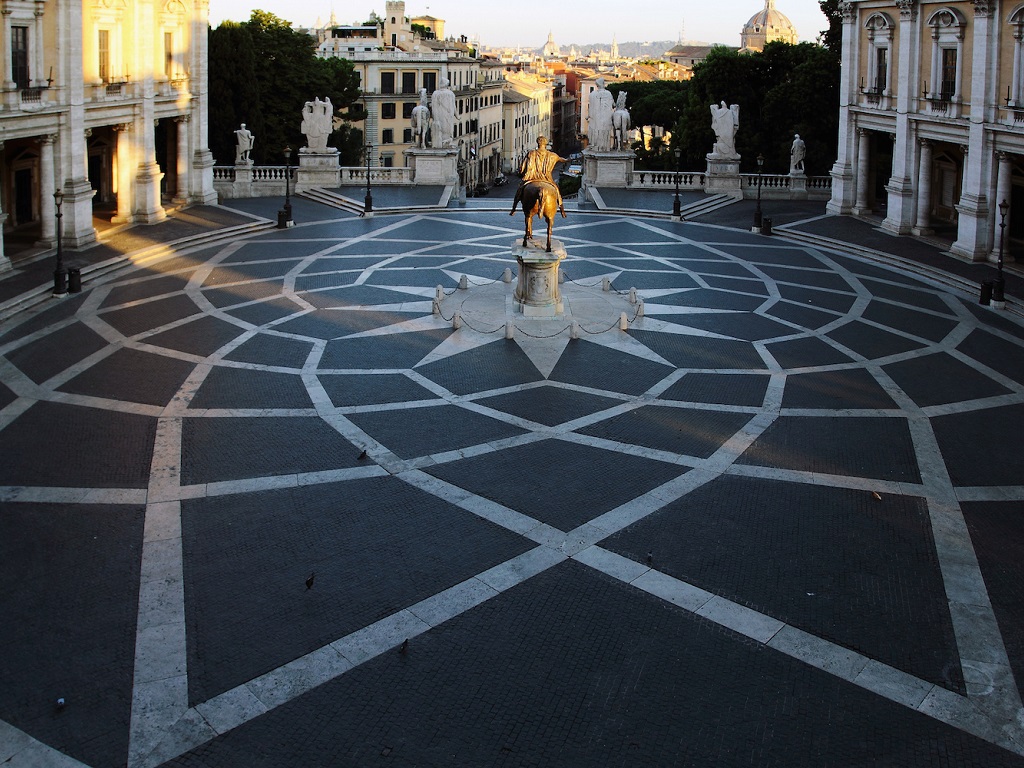
- The statue of Marcus Aurelius is considered the prototype of many equestrian monuments erected in subsequent periods, including Peter I at the Mikhailovsky Castle.
- The statue survived the devastating raids of the barbarians and the religious fanaticism of Christians and has come down to us in its original form.
- The statue is depicted on the reverse of the Italian fifty cent coin.
- A copy of the statue in 1908 was installed in the courtyard of one of the most prestigious North American universities - Brown University (Rhode Island).
- Initially, the statue had a gold coating. An ancient local legend says that it will turn golden again on the Day of Judgment.
8. The evolution of Roman statuary
portrait. Equestrian statue of Mark
Aurelius. late antique painting
(Pompeii, Herculaneum, Stabiae)
Glyptothek (collection of busts) / Roman sculptural portrait - one of the most significant periods in the development of the world portrait, covering about five centuries (I century BC - IV century AD), is characterized by extraordinary realism and the desire to convey character depicted; in ancient Roman fine arts in terms of quality, it occupies one of the first places among other genres.
It is distinguished by a significant number of monuments that have come down to us, which, in addition to art, have significant historical value, as they complement written sources, showing us the faces of participants in important historical events. According to researchers, this period laid the foundation for the subsequent development of the European realistic portrait. The vast majority of the images are made in marble, there are also bronze images that have come down in smaller numbers. Although many Roman portraits are identified with specific individuals or directly bear an inscription indicating who served as their model, not a single name of a Roman portraitist has survived.
One of the roots of the realism of the Roman portrait was its technique: according to many scholars, the Roman portrait developed from death masks, which were taken from the dead and kept at the home altar (lararium) along with figures of lars and penates. They were made of wax and were called imagines.
The political function of the Roman portrait
With the onset of the Empire, the portrait of the emperor and his family became one of the most powerful means of propaganda.
The development of the ancient Roman portrait was associated with an increased interest in the individual person, with the expansion of the circle of those portrayed. Rome is characterized by an emerging interest in a particular person (in contrast to the interest in a person in general in the art of Ancient Greece). The basis of the artistic structure of many ancient Roman portraits is a clear and scrupulous transmission of the unique features of the model, while maintaining the unity of the individual and the typical. Unlike the ancient Greek portrait with its tendency to idealization (the Greeks believed that good man must be beautiful - kalokagatia), the Roman sculptural portrait turned out to be as naturalistic as possible and is still considered one of the most realistic examples of the genre in the history of art. The ancient Romans had such faith in themselves that they considered a person worthy of respect in the form that it is, without any embellishment and idealization, with all wrinkles, baldness and overweight (see, for example, the portrait of Emperor Vitellius).
Roman portrait painters for the first time attempted to solve the problem that ultimately faces contemporary artists, - to convey not only the external individual appearance of a certain person, but also the distinctive features of his character.
General trends
They were created not only by Roman artisans, but also by slave masters, including captured Greeks. However, a general proportion cannot be established.
A large number of forgeries in modern times and false reconstructions
Identification of marble heads by comparison with profiles on coins
The portrait of the emperor (dynastic portraits) is in most cases the most representative for determining general style era, since these works were performed by the most skilled artisans and, in addition, the rest of the subjects, ordering their images, were guided by the fashion set by the emperor.
The works created in the capital were reference. At the same time, a provincial portrait in its style could lag behind fashion for decades. In addition, in the provincial portrait (depending on the region), the influence of the Greek portrait was stronger.
Republic era portrait
The Roman sculptural portrait as an independent and original artistic phenomenon can be clearly traced from the beginning of the 1st century BC. e. - period of the Roman Republic By this time Ancient Rome finally consolidated as a powerful state. Despite the fact that chronologically this period begins with the VI century. BC, when considering portrait art, it is possible to operate only on monuments starting from the 1st century BC. BC, because early works have not survived, and later ones are extremely few in comparison with the works of the period of the Empire.
A characteristic feature of the portraits of this period is extreme naturalism and plausibility in the transfer of facial features that distinguish a particular person from any other person. These tendencies date back to Etruscan art. An important reason that these aspects later intensified was the turning point in Roman history, when individuals began to play a significant role, and the Republic was replaced by a dictatorship. Verismo is a term that is used in relation to realism, turning into naturalism, characteristic of Roman portraits of the end of the Republic (1st half and middle of the 1st century BC). This is the maximum burst of naturalism in the Roman portrait; there are numerous truthful portraits of old people, often ugly (on their basis, a theory has developed about the origin of the portrait from the wax masks of deceased ancestors, see above).
The characteristic psychological features of the portrait of the period of the Republic: "the external resemblance of the statue to the original and a special inner mood that brought all the images together, making them similar to each other, as well as isolation, independence and immersion in the world of personal feelings and experiences."
From the time of Constantine a new stage in the development of the portrait begins. In the early Constantinian period, two directions are divided: the continuation of the tradition and the search for a new solution. Under Konstantin, a new fashion for a hairstyle is established - framing a forehead with a geometrically correct bang in an arc; fashion will continue for a century. Pupils begin to embed in a wide semicircle (for the first time this is found in the portrait of Diocletian from Doria Pamphilj, and now it is used everywhere). This way of depicting the pupil gives the gaze an expression of tension and concentration, which will become typical of portraits of the 4th century. Since Constantine was a strong ruler, in his era there is another surge of classicism, which is always convenient for empires to display calmness and power.
Starting with Constantine, the portrait breaks with the traditions of realism that underlay all the previous development of Roman portrait sculpture. Not without a struggle, the realistic portraits still being made are giving way to the battlefield. The main character of the model of such a portrait becomes severe and ascetic, even religiously fanatical; “For expressiveness, the sculptor uses a new arsenal of figurative means - a strictly frontal setting of the head, a symmetrical construction of facial features, graphic and ornamental rendering of details. But the main thing is the eyes with their motionless, fixed, frozen gaze, in which all facial expression is concentrated.
Under the heirs of Constantine, the classicism of portraits of his time is coming to naught. The eyes are very clearly accentuated, which indicate that everything material and bodily in the portrait is now subject to the spiritual principle (which is natural for the era of the beginning of the power of Christianity). It creates its own style, which combines a generalized and stylized interpretation of a person, devoid of individual characteristics, with a special interest in conveying his inner, exalted spiritual essence. The human face loses its individual-specific features, and with them its significance as a portrait. It becomes an abstract image, an icon.
Equestrian statue of Marcus Aurelius,
Palazzo Nuovo, Rome
The statue of Marcus Aurelius is a bronze ancient Roman statue, which is located in Rome in the New Palace of the Capitoline Museums. It was created in the 160-180s.
Originally a gilded equestrian statue of Marcus Aurelius was installed on the slope of the Capitol opposite the Roman Forum. This is the only equestrian statue that has survived from antiquity, since in the Middle Ages it was believed that it depicts St. Constantine.
In the 12th century, the statue was moved to Lateran Square. In the 15th century, the Vatican librarian Platina compared the images on the coins and recognized the identity of the rider. In 1538, she was placed on the Capitol by order of Pope Paul III. The plinth for the statue was made by Michelangelo; it says: "ex humiliore loco in area capitoliam".
The statue is only twice the life size. Marcus Aurelius is depicted wearing a soldier's cloak (Latin paludamentum) over a tunic. Under the raised hoof of the horse there used to be a sculpture of a bound barbarian.
LATE ANTIQUE PAINTING (POMPEI HERCULANUM STABIA)
In 79, several cities near Naples - Pompeii, Stabia and Herculaneum - died from the eruption of Vesuvius. Started in the 18th century the excavations of Pompeii showed to astonished Europe the life of a Roman city with 20,000 inhabitants, its layout, dwelling arrangements, and their decoration. As a result of many years of excavations, which have not stopped to this day, rather wide streets, a trading square, administrative buildings, temples, craftsmen's workshops, a gladiatorial school, residential buildings - one- or two-story, made of brick or concrete, with tiled roofs, have been opened. The house was divided into two parts. The official center was an atrium with a pool in the middle. The roof over the pool, supported by 4 columns, had an opening - for filling the pool with rainwater and for lighting.
This principle was borrowed by the Romans from the Etruscans. In the center of the pool was placed a fountain, decorated with a statue. In another part of the house, private, where the life of the family took place, the peristyle was obligatory - courtyard rectangular shape, borrowed by the Romans from the Greeks, a favorite vacation spot for the family. Fountains, niches, statues richly decorated the peristyle. Around the atrium and peristyle, utility and residential premises were also grouped.
The floors in wealthy houses were decorated with mosaics - typesetting from natural rocks or colored sea stones - pebbles, as well as from colored glass paste (smalt). In the house of the Faun in Pompeii (the name comes from a bronze figurine of a faun found in the house), a mosaic of 15 square meters was uncovered. m, depicting the battle of Alexander the Great with the Persian king Darius. The excitement of the battle is perfectly conveyed, portrait characteristics of the Greek commander and warriors are given, their clothes and weapons are depicted. The mastery of the composition corresponds to the beauty of color, built on a combination of black, white, red, yellow colors.
The walls of the house were painted with frescoes. In the II century. BC e. most often, the fresco imitated colored marble and various types of stone, which the Romans also learned from the Greeks (the so-called inlay style). In the 1st century BC e., even during the period of the Republic, the style of the paintings has changed somewhat. The murals began to include various architectural details - columns, cornices, pilasters, capitals, sometimes these are large multi-figure compositions, such as, for example, a mystery scene dedicated to the cult of Dionysus, against a red background wall in the Mystery Villa near Pompeii. The figures of Dionysus, his wife Ariadne, participants in the mystery, dancers amaze with harmony, plasticity of movements. The coloring is refined and complex: golden yellow, golden pink is combined with lilac, purple, lilac (the so-called architectural style). Later, already during the period of the Empire, a third style is created, which is often called "Egyptizing" or "candelabra" (according to Egyptian motifs and based on the motif most reminiscent of a candelabra).
In the 1st century n. e., especially in the second half, the paintings are filled with images of fantastic architecture, illusory pushing the space of rooms, gardens and parks, valleys, rivers, hills and squares, genre scenes, still lifes (houses in Herculaneum) become the subject of the image. In the center of the image, as an independent picture, a scene is written on a mythological plot (the so-called fantastic style).






